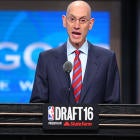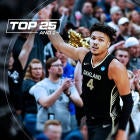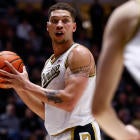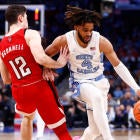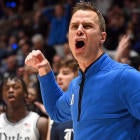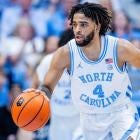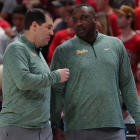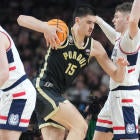If we are to believe his words and glean from his tone, NBA commissioner Adam Silver could catalyze major changes to college basketball in the coming years.
Silver's recent comments about reconsidering the NBA's age-minimum rule for the NBA Draft has once more spurred discussion about what protocol would be better for all involved. Before moving any further, understand this is the perma-reality: There is no perfect solution. There is no rule that benefits the NBA as it does college basketball as it does the players. The NBA is run by smart people, and if there was an endgame that magically worked for everyone invested they'd have found it by now.
So, no matter what, one of the three aforementioned entities — the NBA, college basketball or the player — will be forced into sacrifice in any variable. Obviously, since the NBA and the NBA Players Association bargain the rule, the NBA is not going to be hindering itself.
That leaves college basketball and/or the player on the short end. Over the past decade-plus, the rights of the player have been pushed back. The NBA and college basketball, contrary to what you might have heard (even from the mouth of Silver), have benefited, bigly, from the NBA's rule (which began in 2006) requiring players be 19 years old or a be a year removed from their high school graduation. College hoops gets mega stars, if for a year, while the NBA absolves itself from the curse of choice and temptation by not allowing those players to be eligible.
But if changes are indeed coming, many college coaches advocate a policy similar to Major League Baseball's rules for its amateur draft. MLB's policy is a baseball prospect can head for professional baseball out of high school or choose to go to college, but not allowed to be drafted until after their junior or senior years (not including junior college, where players can enter the draft at anytime).
The idea of moving toward the MLB rule is gaining traction among college basketball coaches. "I'm in favor of the baseball method," Miami coach Jim Larranaga said. "I think if someone feels confident enough in their abilities that they can turn professional right out of high school, then they should be afforded that opportunity. I also believe someone who enters the college ranks should be committed to getting an education and not just use college as prep school for the NBA. I think the baseball rule does that."
In basketball, the idea would likely be upgraded to two years (though Larranaga and some other coaches firmly want it to be three years). If the NBA were to go to this — and despite the scuttlebutt that it would be a better option than the current system — would it actually benefit college basketball more than the current model? I spoke with a number of high-level D-I men's coaches about what they prefer. Most said going to the baseball rule is better than the default one-and-done "farce" (as one called it) that's been in place. Still, the resolutions thrown out were wide-ranging. Philosophical differences exist.
"I get frustrated with the way everything is spun," South Carolina coach Frank Martin said. "Everyone wants to blame college basketball, that we're using these kids. They need to be mad at the NBA that they prevent these kids from going to work."
Martin and a few other coaches are sick of college basketball's reputation taking the hit for one-and-dones. Remember, players are not technically required to attend college, it's just that college is the best one-year option for most.
"Why is that college basketball's responsibility?" Martin said. "They make a choice. You know what my advice would be? You better listen to people that are more in-tune with reality and what the truth is, and if not, it's the United States of America. People open businesses, save their whole lives to open up a business, and a year later they're bankrupt. They make decisions, they take chances. ... Kids want to listen to people that don't tell them the truth, they shouldn't have a safety net."
Of the dozen coaches I spoke with, half speculated whether the NBA would ever go to the baseball option. If a change really is coming to the one-and-done, the baseball rule might not be best for the NBA, though they're in favor of it for their sport.
"Whatever happens in this as we go forward, Kentucky eats first," Kentucky coach John Calipari said. "I'm not saying that to be arrogant. You know it. So, however they play this, it isn't me talking about, 'Well, this is what would be best for Kentucky, or my program.' Or, 'Let these kids get out of here so I don't have to coach against them.' My concern are the kids. What is the best thing? Would the baseball rule work in my mind? Yeah. Heck yeah. I'd love the baseball rule. I'd love the baseball rule for the kids so they have the chance to go right out of high school and get on an NBA roster, and if they're a lottery pick they'll make $20 million. I love it."
The phrase "Kentucky coach John Calipari" might as well be the only synonym with "one-and-done." Calipari, at both Memphis and Kentucky, has become a master of his situation. With the NBA's rule in place for the past 11/going on 12 years, Calipari has established himself as the greatest recruiter in the history of college basketball. Key to keep that in mind when he says he's skeptical that the NBA goes to a baseball model — though he has a point.
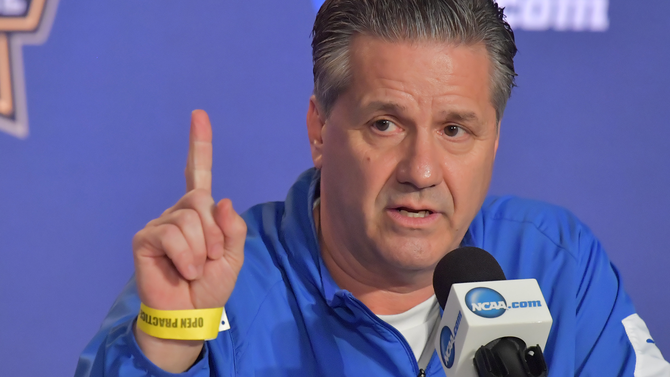
"The NBA doesn't want to do that," Calipari said. "They don't want to go back to drafting high school players. So, whatever you're hearing, I can't see that happening. Now, if it would happen I would love it. I think it would be great."
Many coaches share Calipari's viewpoint and that may stem from a meeting that happened at the 2015 Final Four in Indianapolis. Kiki VanDeWeghe, the NBA's senior executive vice president of basketball operations, spoke to an audience of college basketball coaches at the National Association of Basketball Coaches annual meeting.
"Two years ago in our board meeting we all laughed," Notre Dame coach Mike Brey said. "Whoever brought it up, it's like, 'OK, you can shut up now.' The theme Adam Silver has [gone public with], that was the first time (in 2015) you heard somewhat officially from the NBA saying the same thing. Like, 'This isn't working, we don't like it either.'"
Now a bubbling sentiment could lead to actual change. Don't take Silver's words lightly. He knew how much traction they would get, and for him to feel comfortable enough to publicly express his desire to explore options toward getting out of the one-and-done era, well the NBA's side of this (not necessarily the NBAPA) is effectively transparent at this point.
"Mark Cuban's all gung-ho that we don't know what we're doing in college, they know better how to prepare kids," Martin said. "He's out there saying that, more power to him. Spend money, create the D League, hire coaches, heck he can hire me. College basketball and the NBA, they're two different sports. We're not their minor leagues."
From a practical standpoint, Martin's point is debatable. But if the NBA were to go to a baseball model, how would it better college basketball? Let's remove the NBA's part of this for a moment. You go the route of the baseball rule and college basketball loses out on (most) players like these: Kevin Durant, Greg Oden, Derrick Rose, Michael Beasley, Kevin Love, John Wall, Anthony Davis, Andrew Wiggins, Jabari Parker, Aaron Gordon, Karl-Anthony Towns, Jahlil Okafor, Ben Simmons, Lonzo Ball, De'Aaron Fox, Malik Monk, etc. All highly-rated players coming out of high school, meaning almost all of them would have skipped college.
Many have no problem with that.
"College basketball will be fine," Michigan State coach Tom Izzo said. "The big schools, Duke, Kentucky, Michigan State, we're going to be OK."
And he is right.
College basketball has the NCAA Tournament, massive alumni support and the heaviest inventory of games of any major American sport. But at the height of its powers, like any sport not named the NFL, college hoops is boosted by having star power. In a given year, you take the 10 most talented players, half of them are likely freshmen. This past season brings the heaviest evidence of that, as the forthcoming NBA Draft is conservatively projected to have 15 freshmen taken in the first round — including the first 10 picks all being first-year college players — both of which would set draft records.
Take those players away, you take a little of college basketball's appeal away from the so-called average fan. With the baseball rule, you then, in theory, build up freshmen into sophomores and have players returning and teams getting older and ideally better. But from a philosophical and moral standpoint the question must be asked: How is it any more fair to tell a 19-year-old sophomore-to-be he can't capitalize on his newfound market worth than an 18-year-old freshman-to-be?
Cincinnati coach Mick Cronin doesn't like the current system.
"It hints at racism," Cronin wrote in a text to CBS Sports. "Basketball players are black. Baseball predominantly white. Just how I see it. Why can one group be trusted to make decisions and the other is being regulated? No matter what the rules, people will make mistakes. That has been proven for both sports."
Eliminating the age limit rule as it stands now, only to institute a baseball rule, it arguably opens up a bigger box of problems. If a player wants to leave after his freshman year, you can't force him to be a sophomore.
"We keep talking about colleges or the NBA," Izzo said. "The only time I hear the players brought up is because we're screwing up and taking away their chance to make money. ... Everyone thinks I want to keep kids in school. I could care less. I had Jason Richardson, I was fine with it. There were other guys I thought left too early and their careers went to hell. You look across the country, how many Durants and Kobes are there? There's a million guys that aren't going to be drafted at all. So what happens to these other kids. You're asking a 19-year-old to make those decisions. Everyone says you're holding them back from making money. I think the NBA and us gotta get to together to do more."
Then, there is the agent dilemma. As things are supposed to be governed now, agents are prohibited to be in contact with any NCAA player prior to that player declaring for the draft. With a baseball rule in place, you'll have anywhere from 25-35 high school prospects annually considering their chances at being drafted at 17, 18 years old. With that, agents behind the scenes will (likely more transparently) come into the mix. Inevitably, many of those high school kids will not go pro. But does the relationship with the agent suddenly vanish? Of course it doesn't. This is the big unintended consequence of an NBA-instituted rule potentially having drastic effects at the NCAA level.
Martin, fresh off a Final Four appearance with South Carolina, laid out the scenario.
"How long before the NCAA investigates the whole agent dynamic, how much money was taken, how much money has to be paid," Martin said. "I think we're opening ourselves up to major problems, unless it's an automatic: you can go back to college (if you aren't drafted) but you have to sit a year. Then we're protecting ourselves from any agent nonsense."
Martin continued: "That kid has been dealing with some AAU coach and his neighbor or whoever has been dealing with an agent. So now they come to our campus. That's a dynamic we have to manage from August until March. March, the season is over. Can you imagine having to manage that kid with some agent for that whole offseason … and I'm getting blamed. It's not going to work. I can hire 10 FBI agents, and at the end of the day something wrong's going to happen and I'm going to blamed."
Baylor's Scott Drew, among some others, echoed Martin's concern. Coaches believe the baseball model would lead to an unavoidable situation where coaches get fired and schools get sanctioned because of agent interference.
But Mike Brey offered this: "There is a whole new way of thinking with how to work with agents and how to be more understanding and flexible. Hockey kids, baseball kids have advisers. The NCAA is trying to be more flexible with the agent thing instead of, as soon as you're connected, you're ineligible, you're dead."
Most agree that the NBA, its scouts and general managers, all of them have very little interest going back to evaluating high school players and drafting them on potential. Agents essentially have the run of the league as is, and a baseball model would enrich their control. It's worth acknowledging that some agents essentially get involved behind the scenes with some five-star high school players now, but have maneuvered, somewhat unnoticed, even as players go from high school to college.
"I think the baseball rule is the right option," Izzo said. "Some think that the agents will really be swarming in on them. Those will always be a problem. I want to do what's right for the guy, but not for just three or four guys. The thing agents said to me about (returning Michigan State freshman star Miles Bridges), they make it seem like I'm ruining his life."
Izzo takes it a bit personally, especially now, with Bridges' surprising decision to pass up being a top-20 pick to return to MSU for his sophomore season. Izzo took grief, and he's bothered by it even more so because Bridges was dead set on returning to MSU. He didn't even want to meet with agents. But he is the exception.
"Everyone thinks we're screwing the kid by holding them back, but are we screwing them by pushing them out?" Izzo said. "But how about all the ones that are falling on their ass because they make their one or two million dollars a year and then they're out of the league … I'm just worried about, [people] really act like — agents mostly — college is going to hurt you. I mean, come on. It was all relative, and if every kid was staying two or three years, it wouldn't be hurting anybody."
Izzo is correct that players who would come out as sophomores (or juniors, if the rule was three years) would not be stigmatized as much as they currently are. Even in that context though, some coaches set up the scenario where the agent becomes as big of a hassle as a helicopter parent, potentially threatening transfer over a player's lack of playing time.
What the baseball model offers for college basketball: potentially more stability, eliminates some of the charade of the one-and-done, and presents less problems for coaches at the highest level. It affects, really, 15 to 20 programs. But those programs are the ones that matter most.
"I'm tired of people saying that, in college basketball, we take advantage of our players to make money," Martin said. "They need to allow kids, if they want to declare as eighth graders, they should declare. It is what it is. But if they come to college, their choice, not ours, then they need to stay in college. The rule works in every other sport. I don't know why it's such a problem in basketball. I'm against the age limit. I'm against one-and-done. I'm against two-and-done. ... That way, whoever wants to be in college, come on. Whoever wants to be a pro with this great D League and all these two-way contracts, go. Go. Go. They can go and play in front of 150 people."
Chris Holtmann was interviewed for this piece prior to leaving Butler for Ohio State. As the new Buckeyes coach, he'll now be recruiting at a very high level and dealing with prospects with one-and-done aspirations.
"I would say it's probably going to strengthen, heighten the overall play of our game," Holtmann said. "I don't know the breakdown on how many will go directly. But I think to have, like Henry Ellenson at Marquette. For Marquette to have him another year, think about the difference. This year they would've been even better. Guys like that, it will improve the overall product, and it will certainly, there's no question, it will enhance the programs that regularly recruit one-and-done. No question it would have a benefit, and to some degree maybe a separator."
The sentiment of just about every coach I spoke with: the NBA and NCAA need to meet, multiple times, to really work together to do what's best for the sport of basketball in the United States.
While the assembly line of one-and-done players has boosted college basketball's publicity in many ways, coaches also said that element has become an unwanted one. The biggest reason why coaches want out of the one-and-done is the prayer that — even amid the transfer culture that affects almost every team at the end of every season — taking high-end, NBA-ready (?) prospects out of college basketball removes a heavy element of stress and roster building that didn't exist 15, 20, especially 30 years ago.
If the NBA, NCAA and even the NABC can truly can come together to hash out a plan in the coming months or years — and if high school eligibility of any kind is on the table — then coaches are suggesting a tweak to the draft process. The NBA facilitates the process with a transparent "big board" of sorts that lets prospects know where they general fall in the draft pool. Then, if the prospects stay in the draft but are not selected, they should have the option to enroll for college and enter into the two- or three-year arrangement.
"There has to be a lot of flexibility in this to help out a high school kid," Brey said. "He's a young kid, got bad info, don't hold that against them. Let them come to college."
There are undeniable benefits to the baseball-style agreement. But the flaws are there as well, and the way baseball works is not the way basketball works. College coaches mostly agree the baseball template can make their jobs easier, improve college basketball's stability and wash away much of the freshman charade.
The drawbacks and moral questions with the model are worth heavy discussion. Anything short of going to a baseball model means freshmen will have the option (rightly so) to use college for a year, then move on. If the NBA is steadfast in not wanting to scout and draft 18-year-olds, then college basketball will still have the one-and-done as a conveniently inconvenient — and undeniably entertaining — selling point.












